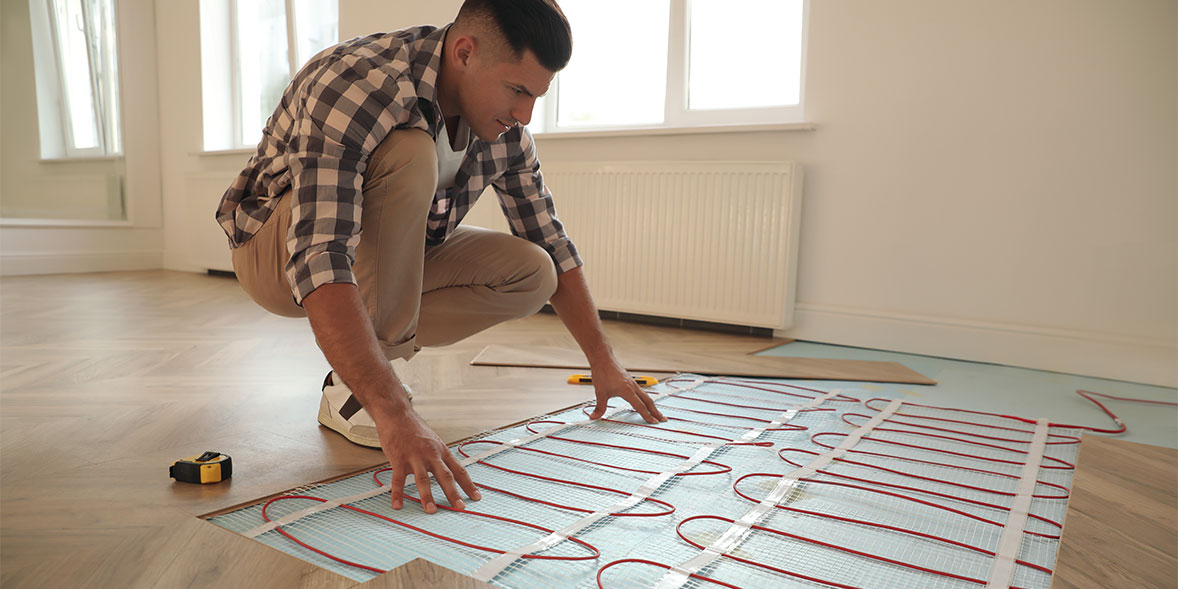
Warmth Beneath Your Feet: Exploring the Comfort and Efficiency of Underfloor Heating
May 14, 2024Underfloor heating (UFH) is becoming increasingly popular in modern homes, appreciated not only for its ability to provide even and efficient warmth but also for the luxurious comfort it offers. This heating solution operates out of sight, delivering consistent heat from beneath the floor surface, making it an ideal choice for those who value aesthetics and functionality. This article delves into the benefits of underfloor heating, explores the different types available, and provides insights on why it might be the perfect heating solution for your home.
The Benefits of Underfloor Heating
Underfloor heating offers several advantages over traditional heating systems like radiators, from efficiency and health benefits to aesthetic flexibility:
Even Heat Distribution
Unlike conventional radiators that heat the air nearest them first, underfloor heating warms the entire floor surface uniformly, distributing heat evenly across the room. This eliminates cold spots and creates a comfortable living environment from the ground up.
Energy Efficiency
Underfloor heating can be more energy-efficient than other forms of central heating. The warmth is radiated upwards from the entire floor, meaning less heat is wasted and lower temperatures are required to achieve the same level of warmth. This can lead to a reduction in energy bills.
Space Saving and Aesthetic Benefits
With no radiators taking up wall space, underfloor heating allows for greater freedom in design and furniture placement. This system is completely hidden, offering a clean and uncluttered look that is particularly beneficial in minimalist or modern interiors.
Improved Indoor Air Quality
Radiators often circulate dust and allergens as they heat the air. In contrast, underfloor heating reduces the movement of air currents and airborne allergens, which can improve indoor air quality and be beneficial for allergy sufferers.
Types of Underfloor Heating Systems
Underfloor heating systems come in two main types: electric (or dry) systems and water-based (or wet) systems. Each has its own set of characteristics and is suited to different types of installations:
Electric Underfloor Heating
This system uses electric wires or heating mats installed beneath the floor surface. Electric UFH is generally easier and cheaper to install than water-based systems, making it ideal for renovations and smaller projects. It is particularly well-suited for rooms like bathrooms and kitchens.
Pros:
- Easier to install in existing rooms
- Lower initial installation cost
- Quick to heat up
Cons:
- Higher running costs compared to water-based systems
- Typically used for smaller areas
Water-Based Underfloor Heating
Water-based systems involve circulating warm water through pipes laid under the floor. This type is usually installed during new builds or major renovations as it requires the floor level to be raised to accommodate the pipework.
Pros:
- More cost-effective in the long run
- Suitable for heating large areas
- Can be connected to various heat sources, including boilers and heat pumps
Cons:
- More complex and costly to install
- Takes longer to heat up
Installation Considerations
The installation of underfloor heating must be carefully considered to ensure optimal performance and efficiency:
Insulation
Proper insulation is crucial for maximizing the efficiency of an underfloor heating system. Insulating the subfloor ensures that heat is directed upwards into the room rather than being absorbed into the ground.
Flooring Materials
The choice of flooring material can greatly affect the performance of underfloor heating. Materials like ceramic tile and stone are the best conductors of heat, making them ideal choices. Wood and laminates can also be used but require more careful selection and control to avoid damaging the material.
Control Systems
Modern underfloor heating systems are compatible with smart thermostats, allowing for precise control over temperature and timing. This can further enhance the system's efficiency and ensure that the heating is only on when necessary.
Running Costs and Efficiency
While the initial setup cost for underfloor heating, especially water-based systems, can be high, the overall running costs are generally lower compared to traditional heating systems. This is due to the lower temperatures required to heat a space efficiently, coupled with the excellent distribution of heat.
Conclusion
Underfloor heating offers an effective and luxurious way to heat your home. Whether you choose an electric or water-based system, the benefits of even heat distribution, energy efficiency, aesthetic freedom, and improved air quality make UFH an appealing choice for new constructions and renovations alike. By understanding the different systems available and considering the specific needs of your home, you can invest in an underfloor heating solution that provides comfort and efficiency for years to come.
- No Comments!